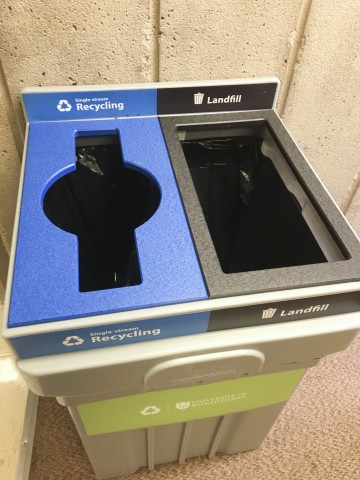In a world where going green is less of an option and more of a necessity, where does Saskatoon stand? While our leadership may be heading in the right direction, Saskatoon can barely be called a sustainable city.

Individual action is the first step to fixing waste problems in Saskatoon.
Sustainability is most often defined as the ability of a society to meet the needs of the present generation while not sacrificing the ability of future generations to meet their needs. Although environmental sustainability gets the most attention, there are three major pillars that make up sustainability — environment, economy and society.
While there is no one way to measure sustainability, a commonly used and simple way to measure it is to calculate a region’s ecological footprint. This measures the total area that would be required to sustain the population of a region at their current rate of resource consumption.
According to the Global Footprint Network, “to live within the means of our planet’s resources, the world’s ecological footprint would have to equal the available biocapacity per person on our planet, which is currently 1.7 global hectares” — or GHA.
The GFN also states that Canada’s ecological footprint per capita is about 8.8 GHA, the fifth highest in the world. Saskatoon’s ecological footprint per capita in 2014 was 7.4 GHA. In 2005, Vancouver’s was about 7.71 GHA, Calgary’s was 9.86 GHA, Winnipeg’s was 7.15 GHA, and Toronto’s was 7.36 GHA.
In comparison to the rest of Canada, Saskatoon isn’t doing too bad. But when you take into consideration the impact of that number on a global scale, we are living far beyond our means.
Comparing ecological footprints alone is not a completely accurate representation of sustainability because it ignores the efforts of municipalities to increase their sustainability. Saskatoon’s municipal government has been taking many steps to foster sustainability in our city and is attempting to lead us in the right direction.
Best practices for any city trying to encourage sustainability include creating a shared understanding of sustainability, integrating sustainability into long-term planning and policies, reporting on progress and communicating the need, vision, strategies and priorities for sustainability to its citizens.
Sustainability in Saskatoon is already being incorporated into long-term planning and is being addressed in five of the 10 strategic areas of development for 2020. Saskatoon also has an Environmental Advisory Committee, which provides advice to City Council on policy matters relating to environment and sustainability.
Saskatoon is also reporting on its progress by means of an Environmental Leadership Report. This report includes information on four main areas of development — land, air, water and waste.
Other efforts of the city to try to increase sustainability are the development of a wetland policy, the use of integrated pest management in municipal parks, the support of community and allotment gardens, a new green-cart program for yard composting, and the support of alternative energy projects.
But despite the efforts of the city, we are still falling farther and farther behind.
Over 100,000 tonnes of CO2 were pumped into the atmosphere in Saskatoon in 2013. Greenhouse gases are one of the root causes of climate change, and continuing to increase our use of fossil fuels is a large contributing factor in the production of greenhouse-gas emissions.
Our landfill is also becoming dangerously full. The city has not been meeting their waste-diversion targets, and we could be looking for a new landfill soon, if we are not able to drastically decrease our waste production.
Our transit system is fundamentally flawed, and biking is nearly impossible. Many of our communities lack accessible and affordable food. Many of our Indigenous youth are living in poverty or incarcerated, and all of these issues seem to be falling through the cracks.
So, is Saskatoon sustainable? No. But we can be, and with support from our municipal government, we will be.
—
Sydney Boulton
Photo: Michaela DeMong